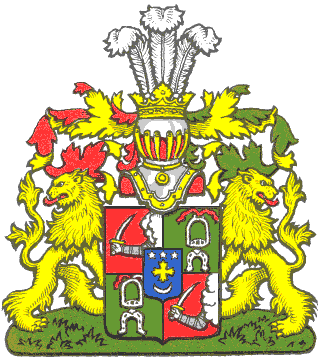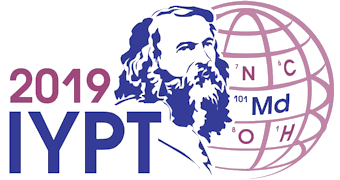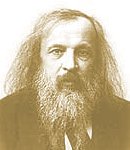

Dmitri Mendeleev (1834-1907). Russian chemist.
[ Dimitri Mendeleyev, Mendelejev, Mendeleyeff, etc. ]
This coat-of-arms of
Dmitri Mendeleev (1834-1907)
is a copyrighted image
drawn by the renowned heraldic artist
Carl-Alexander von Volborth (1919-2009).
Quarterly; [1 & 4] Gules, an ironclad arm from a cloud Proper
holding a sword Argent;
[2 & 3] Vert, a horseshoe below a stirrup Argent strapped Gules.
On an inescutcheon Azure, a cross patonce Or,
3 mullets in chief and a crescent in base Argent.

In the 1860's, several chemists
(working independently) observed that the basic properties of chemical
elements with similar atomic weights repeat themselves in sequence,
by order of atomic mass, for heavier elements.
Dmitri Mendeleev
carried this idea further than anyone else
in his influential chemistry textbook (1869).
In particular, Mendeleev noticed several gaps
in this scheme and attributed them to undiscovered elements whose chemical
properties he correctly predicted.
Mendeleev's classification can be construed as an empirical discovery
of what we now call the atomic number (Z) of a chemical
element (now known to be the number of electrons orbiting its nucleus).
The chemical properties of an atom are entirely due to its electronic structure
and the allocation of electrons under quantum rules
(explained by Schrödinger
in 1926) is the cause of the periodicity presented by Mendeleev in 1869.
Because the atomic weights are not always increasing with Z,
Dmitri Mendeleev postulated that the observed discrepancies were
due to measurement errors.
He was wrong on that particular detail:
For example, the atomic mass of tellurium
(127.6 g/mol for Z=52) is indeed higher than that of iodine
(126.9 g/mol for Z=53).
Incidentally, Dmitri Mendeleev also sought to give chemical
explanations for two scientific mysteries of his times by
speculating the existence of elements with an atomic mass lower than
that of hydrogen:
- One very light element as the constituent
of the electromagnetic aether.
(At the time, it was firmly believed that lightwaves existed in a
vacuum
because of some kind of unknown vibrating medium permeating it.)
- A slightly more substantial element
(which Mendeleev dubbed coronium)
to explain a prominent spectral line in the
solar corona
(actually due to highly-ionized iron).
Well, Dmitri Mendeleev was not entirely wrong about such
speculations, since there is indeed an overlooked unstable element
which is barely heavier than hydrogen
(although it has nothing to do with the aether or the corona).
It has a half-life of about 15 minutes and it's
sometimes called neutronium.
The atomic number of neutronium
is zero and its nucleus consists of a single free neutron.
Of course, due to its utter lack of electrons, neutronium
cannot take part in
any chemical reaction whatsoever; it's the ultimate inert gas!
Arguably, neutronium can form extremely heavy isotopes
under the influence of gravity, since we may view every
neutron star as a
huge nucleus of neutronium. 




